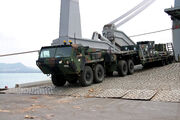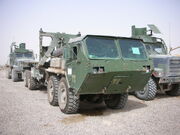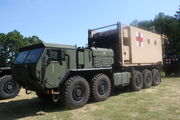
LVS fifth-wheel variant, towing an M870A2 semitrailer

LVS self-loader variant (MK48/18A1) with MAK Armor-kit
The Logistics Vehicle System (LVS), is a modular assortment of eight-wheel drive all-terrain vehicles used by the United States Marine Corps.
The LVS was fielded in 1985 as the Marine Corps heavy tactical vehicle system.[1] It was designed and manufactured by the Oshkosh Corporation. The United States Army has a similar tactical vehicle called the Heavy Expanded Mobility Tactical Truck (HEMTT). The key differences between the two is the LVS's ability to interchange Front Power Units with Rear Body Units. The LVS also steers through both standard wheel pivoting (as on a typical automobile) and hydraulic yaw steering (by articulating the Front Power Unit against the Rear Body Unit). This gives the LVS remarkable maneuverability for its size. It and the LVSR can haul up to 22.5 tonnes (22,500 kg) on highways.[1]
The Logistics Vehicle System Replacement (LVSR) is an upgraded version, first fielded in 2009.[1] The $740.2 million contract with Oshkosh signed in June 2006 will yield 1,592 of the 36 feet (11 m) units to the Marine Corps. The articulation system has been discarded in favor of a ten-wheel system, the TAK-4 suspension system used in the Medium Tactical Vehicle Replacement for off-road capability, an improved weapons turret with electric motor, and integrated vehicle armor with add-on kits available. The front two and back two axles can be steered, reducing the turning radius to 83 feet (25 m) from the 90 and 100 feet (27 and 30 m) without.
Variants[]

LVSR with containerized ambulance bay
The LVS is composed of a Front Power Unit (FPU) coupled to a Rear Body Unit (RBU). The FPU can be driven on its own, but is front-heavy in this mode and prone to nose-diving when the brakes are applied. A suspension lockout strut reduces this problem. When describing a truck it is remarked by the combination of both units, for example, an MK48 FPU attached to an MK18 RBU is called a "48/18". For MK16's, which tow M870 semi-trailers, the type of trailer is added as well, i.e. "48/16/870A2".
- Front Power Units
- MK48 houses a unique turbocharged and supercharged 550hp Detroit Diesel V8, mated to a 4-speed Allison Transmission. The engine also powers an alternator, air compressor and hydraulic pump. The MK48 also houses the cab, for a crew of 2.
- MK48A1 offers slight improvements to the original MK48. Those improvements include a revised battery box and cover, an extra cab entry step for both sides, modified air intake cover, and added handles and steps to ease climbing on top of the power unit.
- Rear Body Units
- MK14 Flatbed is 20 feet (6.1 m) long and features locks for ISO containers. The MK14 can hold a single twenty-foot equivalent unit (TEU) sized container, or three SIXCON units (pump or tank modules). There are also accommodations for tie-down hooks and ratchet straps for securing cargo. When equipped with a tow bar, two MK14's can be joined and towed by a single MK48 power unit. This is referred to as a 'Tandem Tow' or 'TT'.
- MK15 Recovery Vehicle is capable of recovering LVSs, MTVRs and HMMWVs.
- MK16 Fifth-wheel is designed to tow the M870 family of semi-trailers. It is the shortest of the FPU/RBU combinations, creating a smaller turning radius. This is useful, as when towing an M870 trailer, it becomes the Marine Corps longest tactical vehicle.
- MK17 Material Handling Crane (MHC), features a slightly shorter flatbed (8 by 16 feet (2.4 m × 4.9 m)) than the MK14. This is to accommodate the MHC at the rear of the unit. The boom is rated at a maximum lifting capacity of 15,000 pounds (6,800 kg). The MK17 can also be fitted with benches to carry 20 combat-loaded Marines. This is rare however, as personnel transport is now mainly handled by MTVRs and HMMWVs.
- MK18/18A1 Self-Loader is capable of loading ribbon bridges, small boats, containers, and SIXCON modules with no external heavy-equipment support. The 18A1 features improvements to the loading and offloading process. The 18A1 features a prominent 'stick-figure'-shaped Front Lift Adapter (FLA) rising from the middle of the vehicle.
Specifications[]

LVS Flatbed variant (MK48/14) with MAK armor kit and ring-mount weapons turret
| Vehicle nomenclature | Length | Curb weight | Payload capacity onroad / offroad | Turning radius |
|---|---|---|---|---|
| MK48/A1 | 238.5 inches (606 cm) | 24,500 pounds (11,100 kg) | N/A | N/A |
| MK48/14 | 456 inches (1,160 cm) | 40,300 pounds (18,300 kg) | 45,000 pounds (20,000 kg) / 25,000 pounds (11,000 kg) | 38.5 feet (11.7 m) |
| MK48/15 | 444 inches (1,130 cm) | 50,550 pounds (22,930 kg) | 20,000 pounds (9,100 kg) | 38.5 feet (11.7 m) |
| MK48/16 | 398 inches (1,010 cm) | 40,550 pounds (18,390 kg) | 46,000 pounds (21,000 kg) | 32.5 feet (9.9 m) |
| MK48/17 | 456 inches (1,160 cm) | 47,200 pounds (21,400 kg) | 39,000 pounds (18,000 kg) / 20,000 pounds (9,100 kg) | 38.5 ft |
| MK48/18 | 456 inches (1,160 cm) | ? | 45,000 pounds (20,000 kg) / 25,000 pounds (11,000 kg) | 38.5 feet (11.7 m) |
| LVSR | 430 inches (1,100 cm) | ? | 45,000 pounds (20,000 kg) (200,000 pounds (91,000 kg) towed GCWR) | 83 feet (25 m) |
- System-Wide Specifications
| Crew: | 2 |
| Width: | 96 inches (240 cm) |
| Height: | 102 inches (260 cm) |
| Maximum speed: | 57 miles per hour (25 m/s) on roads (65 miles per hour (29 m/s) for LVSR[2] |
| Maximum range: | 300 miles (480 km) |
| Highest climbable grade: | 60% |
| Steepest approach angle: | 45° |
| Steepest departure angle: | 45° (48° for MK48/16, 40° for MK48/17) |
| Maximum side slope: | 30% |
| Maxmium fording depth: | 60 inches (150 cm) |
See also[]
- Heavy Expanded Mobility Tactical Truck
- Medium Tactical Vehicle Replacement
- High Mobility Multipurpose Wheeled Vehicle
- LVS and MILITARY VEHICLE INFORMATION FORUM
Operators[]
United States
Egypt
References[]
| This page uses some content from Wikipedia. The original article was at Logistics Vehicle System. The list of authors can be seen in the page history. As with Tractor & Construction Plant Wiki, the text of Wikipedia is available under the Creative Commons by Attribution License and/or GNU Free Documentation License. Please check page history for when the original article was copied to Wikia |
- ↑ 1.0 1.1 1.2 Lamothe, Dan (Thursday Oct 22, 2009 11:20:57 EDT). "First LVSR truck arrives in Afghanistan". Marine Corps Times. Gannett Company. Retrieved on 2009-10-23.
- ↑ LVSR on Oshkosh website
- Headquarters Marine Corps Factfile
- Logistics Vehicle System (LVS) by Federation of American Scientists
- Logistics Vehicle System Replacement (LVSR) by Federation of American Scientists
- Additional information for the LVS at GlobalSecurity.org
- Additional information for the LVSR at GlobalSecurity.org
External links[]
| ||||||||||||||